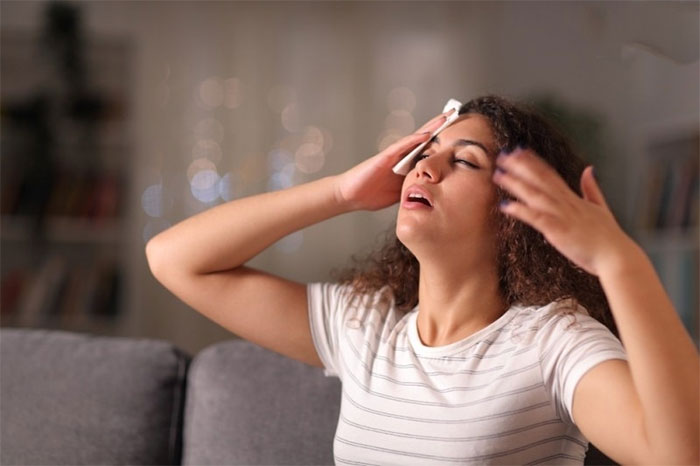What happens when the body doesn't sweat?
An inability to sweat could be due to anhidrosis. A prolonged lack of heat that prevents the body from cooling itself can cause serious heat-related complications such as heatstroke, muscle cramps, or exhaustion.
What is non-sweating syndrome?
1. Overview
Anhidrosis is another name for a condition in which the body does not sweat as it should, which prevents the body from cooling itself, which in turn leads to overheating, sometimes leading to heatstroke and even death.
There are many factors that cause anhidrosis, including trauma to the skin, certain diseases, and medications.
Treatment of the body's lack of sweating caused by anhidrosis can be highly effective when the cause is found.
2. Symptoms
Signs and symptoms of anhidrosis include:
- Little or no sweat
- Dizzy
- Muscle cramps or weakness
- Blushing
- Feeling hot
Heat loss can occur on most skin or in certain areas of the body.
The failure of one area to dissipate heat will result in compensation by increasing heat loss in other areas of the body. Anhidrosis prevents the body from cooling itself, so people with Anhidrosis should limit intense exercise, strenuous work, and being out in the sun to avoid the risk of cramps, heat exhaustion or even Sun stroke.
Anhidrosis can be the primary disease, or a symptom of another condition, such as diabetes or a skin injury.
If it's almost impossible to sweat in hot weather, during work or intense exercise, see your doctor for early diagnosis and treatment.

Symptoms of body not sweating are dizziness.
3. Cause
Anhidrosis can be a congenital or medical condition affecting the nerves and skin, or dehydration. Sometimes the cause of Anhidrosis cannot be found.
The main causes of anhidrosis include:
- Self-acquired, like some congenital dysplasias that affect sweat gland development
- Genetic conditions that affect the metabolic system such as Fabry disease
- Connective tissue diseases such as Sjogren's syndrome, which cause dry eyes and mouth
- Skin damage from burns, radiation therapy, and pore-clogging diseases like psoriasis
- Nerve damage caused by diabetes, alcoholism and Guillain-Barre . syndrome
- Medicines such as morphine and botulinum toxin type A, and those used to treat mental disorders
4. Complications
Heat-related illnesses are the most serious complications of anhidrosis. Children are especially vulnerable because their body temperature rises faster than adults and their bodies release heat less efficiently.
Failure to self-regulate temperature can cause many complications for the body, especially children, as the temperature rises faster and releases heat more slowly than adults. Common complications of Anhidrosis include:
- Heat spasm: Symptoms include pain or muscle spasms. When suffering from this condition, you should rest in a cool place and drink more water. If the contraction lasts more than 1 hour, you need to go to the hospital immediately
- Exhaustion: Symptoms include weakness, nausea, and a rapid pulse. In this situation, the patient should be brought to a cool place and call an ambulance if it lasts more than 1 hour
- Heatstroke: Heatstroke occurs when the body temperature of 39.5 degrees Celsius or higher causes red, hot, or dry skin. If not treated immediately, heatstroke can lead to loss of consciousness.
5. Prevention
Anhidrosis usually cannot be prevented, but its serious complications are possible. Accordingly, you need to pay attention:
- Wear loose, light clothing when it's warm.
- Stay indoors on hot days.
- Use a spray bottle containing water to cool your body.
- Monitor activity levels closely to avoid overheating.
- Learn the signs of heat-related illness and how to treat it.
The lack of sweat in the body can seriously affect the health of the patient. Therefore, you should consider the factors and take preventive measures to avoid dangerous complications.
- 9 think less people know about sweat
- With sweat, you can know a lot about health and crime
- How does the body smell?
- Why do some people sweat more than others?
- Body odor from a scientific perspective
- 5 unexpected things you don't know about body odor
- 4 body odor reveals your health problem
- The touching story behind how to fight mosquitoes effectively
- The more stressful, the more the body smells 'bad' - what mechanism is that weird?
- Breakthrough in the study of artificial sweat glands
- How to help you know right away whether you are susceptible to armpit odor
- 10 common misconceptions about the human body
 13 causes of non-itchy rash
13 causes of non-itchy rash How the mouse with human ears changed the world?
How the mouse with human ears changed the world? The truth about 'fried rice syndrome!
The truth about 'fried rice syndrome! What is dental implant?
What is dental implant?